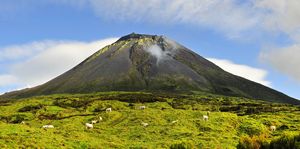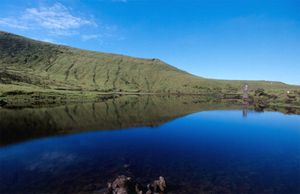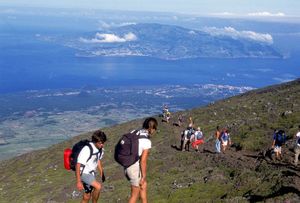
Tour to the Pico, Pico Island
Dare to go on a tour to Pico (Peak) in Pico Island on foot or by all-terrain vehicle.
The Pico (Peak) raises in the Pico Island, in the centre of Azores, and is the highest peak in Portugal.
It is a great mountain hiding surprisingly beautiful places, such as the small lagoons group protected as nature reserve.
To climb to the peak it is needed to have a guide. There are numerous companies taking the adventurer by all-terrain vehicles up to the basis of the mountain. From there it is necessary to go on foot, something complicated especially when the weather conditions are not the best ones.
You can quickly reach the basis of the mountain from Madalena by the EN 3, being just 12 kilometres. To the right, you will find signaled the mouth of the Furna de Frei Matias, a 650 metres volcanic gallery not recommended to be explored without a guide.
Once in the tableau you will find lots of old Cabeços (hillocks), but all of them look smaller in comparison to the great Pico.
Around 800 kilometres height survive some stunted burnt by the salinity cedras, as well as persistent heathers and other short ericaceae plants located even at 1,800 metres height.
From the highway, located around 870 metres height, you will find the road that goes up to the 1,231 metres height Cabeço das Cabras Hillock, from where by a surrounded by vegetation road you will arrive to the top of the Pico (Peak) with its 2,351 metres.
To make the tour are necessary at least two hours. The upper side of the volcanic cone, known as Pico Grande, is devoid of vegetation. If you have extra half an hour you can visit the Piquinho, a minor volcanic cone, of 50 metres height,above the crater’s plateau, at which feet raise various black smokers. From this privileged viewpoint, if the weather is good, you will see all the islands of the Azores Central Group, creating an unique unforgettable experience.
The Pico area also boasts interesting places such as a group of seven medium-sized lagoons and many more smaller ones, surrounded by a sort of wavy high pasturelands where the cattle is.
One of them is the Capitão Lagoon, mainly virgin and protected as a Nature Reserve, which can be reached by a left diversion around 900 metres before the EN 3 meets the EN 2. Here, with the Pico present all the time, the red beak muscovy duck makes its nest, as well as several fish species inhabiting here which are not eaten due to they are not as tasty as other ones.
Nearby it is located the Cabeço da Lavandeira Hillock. If you keep going by a straight track you will arrive to the Caiado Lagoon, with less vegetation than the previous one, accompanied by a group of three lagoons called ilhéu, Rosada and Peixinho.
From here, you can keep going on foot by improvised hiking routes which are not very common in the island.
Mapa Interactivo:
Why "Portugal Travel"?
Portugal Travel is an organization of Portuguese agencies whose objectives are:
- ✓ To make Portugal, its culture and its heritage known.
- ✓ To promote sustainable tourism.
In collaboration with:
Escola Superior de Hotelaria e Turismo do Estoril
Turismo de Portugal
Copyright PortugalTravel.org © - All rights reserved.






